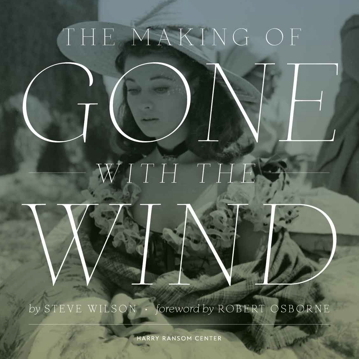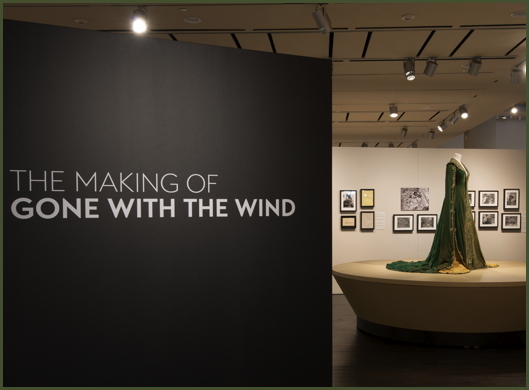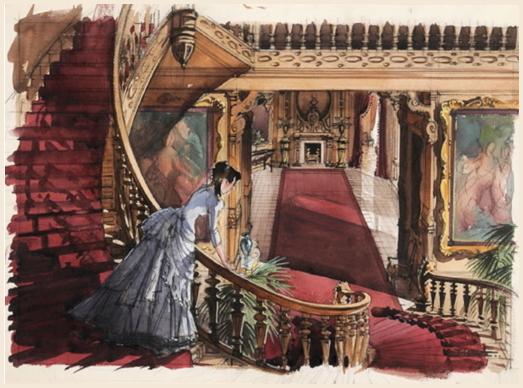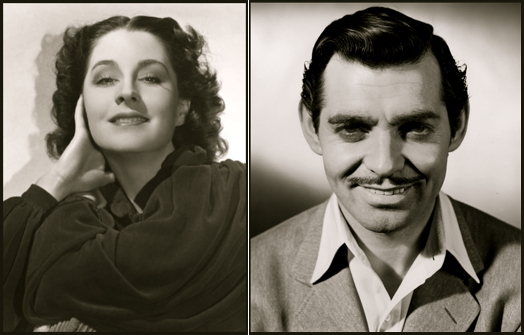Just when I thought I could answer any trivia question on David O. Selznick's 1939 production of Gone with the Wind, comes a treasure of new material in Steve Wilson's book, The Making of Gone with the Wind. It is the companion piece to an exhibit now at the Harry Ransom Center at the University of Texas in Austin until January 4, 2015. Steve Wilson is also the curator of the exhibit. The large 336-page hardcover volume is exceptionally handsome and refreshingly informative. In tandem with the vast amount of related information available on the exhibit's website -- it turns out the story behind the making of the most popular film of all time is far richer and much more complex than previously told.
In celebration of the film's 75th Anniversary, Wilson's publication is packed with an exciting array of photos, along with clear images of related and crucial memos to and from producer Selznick, hourly shooting schedules, a variety of artistic renderings including costume sketches by Walter Plunkett, storyboards and much more. The materials for the book and the exhibit are drawn from the collection of David O. Selznick, all of which is permanently housed at the Ransom Center. It is a working sanctuary devoted to a uniquely American experience and evergreen cultural phenomenon.
"That is the mark of a great archive," said Steve. "You can go back to that well and keep drinking from it. There are so many stories to tell and I've just touched the tip of the iceberg with what I've got in the book and the exhibition. There is still so much I just couldn't get to."

Designer Walter Plunkett. Gown worn by Vivien Leigh, photo by Pete Smith. Images courtesy of Harry Ransom Center
"We got the Selznick collection in 1980. It's gigantic! David O'Selznick died in 1964. His two sons, Jeffrey and Daniel, maintained the collection at Bekins Storage in Los Angeles for a number of years. It got to be really expensive. They began looking for an institution that would make it available for students and scholars. At that time, the University of Texas was the only institution that had the wherewithal to pay to have the material catalogued, re-housed in acid-free boxes and made available. It is the largest collection at the Ransom Center -- some 5,000 document boxes. About ten percent of it, 500 boxes, is Gone with the Wind. I'm really glad we got it. The collection is remarkable and is almost constantly in use."
A particularly beautiful component of the exhibit and book are the film's many concept paintings -- certain free thinking illustrations that led to final set designs and key dramatic shots contained in various scenes. Knowing the film, these preliminary renderings are incredibly persuasive and reveal the passion and genius of Selznick's team of designers. I asked Steve Wilson how much time went into the creation of his own project.
"Almost as long as it took Selznick to make the film," he responded. "We've known for a number of years we wanted to do an exhibit to mark its seventy-fifth anniversary. In 2010, we mounted an on-line fundraising campaign to conserve the five dresses we have in the collection. It went viral immediately. We thought it would cost thirty thousand dollars. We raised that in a couple of weeks. Contributions of five or ten dollars came in from all over the world to save these dresses. Three of them are originals - the curtain dress, the burgundy ball gown that Rhett makes Scarlett wear to Ashley's birthday party, and the dressing gown when she tells Rhett she does not want any more babies. We also have two costume replicas that were made back in the early '80s -- her wedding dress and the blue wrapper with fur trim from the scene where Bonnie has her accident. We have the originals, but we felt we would damage them by putting them on mannequins. But the copies are perfect. You would be hard pressed to tell the difference between them and the originals."
1939 was a period of convergence in the development of American cinema. Every advancement in the arts and sciences of filmmaking was in play that year and every studio had a roster of performers now referred to as "immortal". Since the introduction of sound in 1929 and the entrance of the censor in 1934, Hollywood had never seen such a profusion of excellent work. Every studio was represented by at least one title in the following year's Academy Award nominations. David O. Selznick's Gone with the Wind received ten of those Oscars. Seventy-five years later, in its Diamond Jubilee, what was topical then remains very much in discussion today. One area of the Ransom Center exhibit focuses on the response by the African American press - specifically, a man named Earl Morris who wrote for the Pittsburgh Courier.
"Just as they started filming the movie," says Wilson, "Morris published a series of blistering editorials about what he called 'the hate word' -- now 'the N-word' -- and its use in the script, at least as far as he knew, based on the novel. Selznick became really upset because he always described himself as a 'Hollywood Liberal'. For a long time, Selznick had a correspondence with Walter White of the NAACP about the film and about historical accuracy. Also, in a memo to [production assistant] Jock Whitney, Selznick makes the connection that he himself is Jewish and knows what is going on in Europe. So, he felt that he understood the minority point of view. As a direct result of these editorials, Selznick ended up taking the word out of the script. If it were to have stayed, we wouldn't be watching the movie today. There still are racial issues involved with the film, but I think this is a great opportunity for us to talk about those issues."

Vivien Leigh as Scarlett. The curtain dress displayed in The Making of Gone With The Wind. Photo, Pete Smith. Images courtesy of The Ransom Center
Everyone can find a new or expanded avenue of historical exploration through this incredibly well organized on-line archive of material on Gone with the Wind. For me, it is about Selznick's wildest ride -- the search for the perfect Scarlett O'Hara. During the three years between the publication of the novel and the release of the film, thousands of letters poured into his offices with suggestions and protests about who was in contention for the most coveted dramatic role since Shakespeare's Lady Macbeth. For me, the most exciting revelations are about the role's first contender -- MGM's primary leading lady, Norma Shearer.
"Knowing you are a fan," said Steve, "it surprised me that she was a part of the deal with MGM. In those days, actors were pretty much owned by the studios. You could not go directly to the actor to get them to be in your movie. You had to make a deal with the distributor to have the actor loaned to you. Selznick had to make a deal with MGM to get Clark Gable. When they first started to get the deal together, Norma Shearer was part of that deal. She had been paired with Clark Gable a couple of times [A Free Soul, Strange Interlude] and they were about to make Idiot's Delight. I believe she was the driving force behind the deal. She went to Louis B. Mayer and Nicholas Schenck [chairman of the board of Lowe's, Inc., the owner of MGM] to say she wanted to be in this movie. But the public was not behind her as Scarlett. Some thought she could play Melanie. At one point, when Shearer thought she was going to play Scarlett, she sent a super secret memo to Selznick outlining her thoughts about the script. Basically, she thought that Scarlett -- in the early part of the movie -- was fine, but later on was not sympathetic enough. She wanted Selznick to change the script to make Scarlett more sympathetic. As it turned out, Shearer leaked this to Hedda Hopper and then the letters really started pouring in. So, that was a surprise to me to learn that Norma Shearer was so involved in that aspect of it and that she really wanted the part so badly that she really went after it very aggressively."
That correspondence is preserved in the David O'Selznick Collection. I confessed to Steve Wilson that I envy his job as Curator. Now I'm dreaming about a pilgrimage to Austin, the Harry Ransom Center and a tour of The Making of Gone with the Wind.



